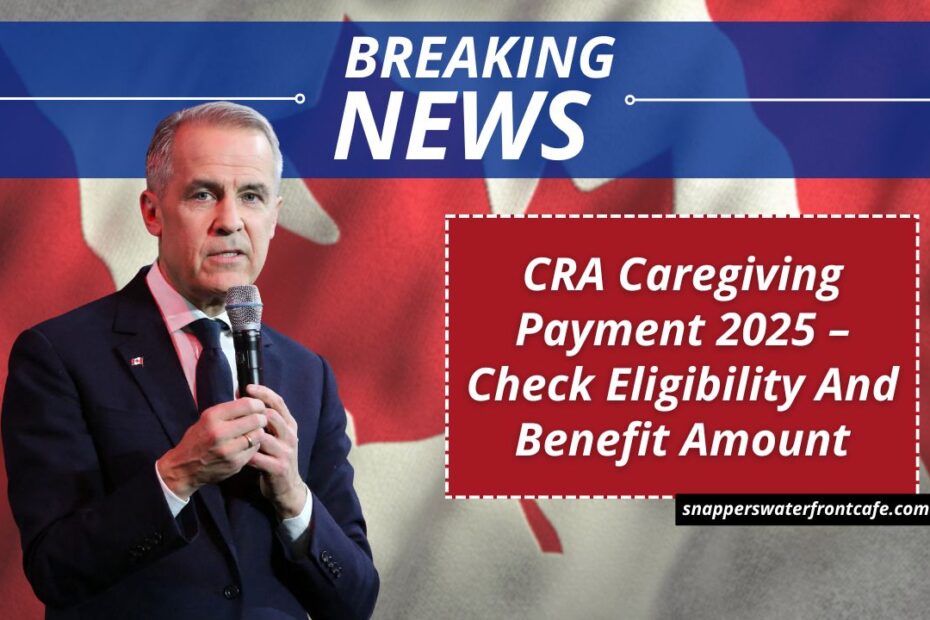Caring for a loved one who is ill, disabled, or requires additional daily support can put a heavy financial and emotional strain on Canadian families.
To help ease this burden, the Canada Revenue Agency (CRA) and the federal government provide financial relief through the Canada Caregiver Credit (CCC) and Employment Insurance (EI) Caregiving Benefits.
In 2025, these supports remain a critical lifeline for individuals who must step away from work or take on additional responsibilities at home to look after a spouse, child, parent, or other close relative living with an impairment.
The term “CRA Caregiving Payment 2025” often causes confusion, as many people expect it to be a direct cheque from the government.
In reality, the CCC is a non-refundable tax credit that reduces the amount of federal income tax you owe, potentially boosting your refund if you have enough taxable income.
On the other hand, the EI Caregiving Benefits provide actual weekly payments to caregivers who temporarily stop working to provide care.
This guide breaks down who qualifies, how much you can receive, and how to claim both forms of support in 2025.
Whether you are looking to lower your taxes at filing time or replace your income while taking time off work, understanding the rules of the CRA caregiver programs can ensure you get the maximum benefit you’re entitled to.
What Is the Canada Caregiver Credit (CCC)?
The CCC is a non-refundable federal tax credit for people who support a spouse or common-law partner, an eligible dependant, an infirm child under 18, or other infirm dependants because of an impairment in physical or mental functions.
You may claim the credit for specific relatives (including parents, grandparents, siblings, aunts/uncles, nieces/nephews) who resided in Canada at any time in the year and depend on you for basic needs such as food, shelter, and clothing.
Key point: Because it’s a non-refundable credit, the CCC does not pay cash directly. It reduces your federal tax.
If your tax is already zero, the credit generally won’t generate a payment by itself.
Who Can You Claim in 2025?
You may be able to claim the CCC if you support:
- Your spouse or common-law partner with an impairment.
- An eligible dependant (e.g., someone you could claim on line 30400).
- Your child under 18 with an impairment who needs significantly more help than other children of the same age.
- Other infirm dependants (18+) who are your or your partner’s close relatives (child, grandchild, parent, grandparent, sibling, aunt/uncle, niece/nephew) and resided in Canada at any time in the year.
CRA Caregiving Amounts for 2025 (CCC)
Exact amounts and line numbers matter. For 2025, the CRA outlines the following maximum claimable amounts and where they appear on your return:
| Category (who you’re supporting) | 2025 maximum CCC amount | Where to claim (line) | Income thresholds / notes |
|---|---|---|---|
| Spouse or common-law partner (with impairment) | $2,616 is included in the spouse amount calculation plus up to $8,375 under the caregiver amount | 30300 (spouse amount) and 30425 (caregiver amount) | For line 30425, your partner’s net income must be between $8,397 and $28,041 to claim up to $8,375. |
| Eligible dependant (18+) | $2,616 in the eligible dependant calculation plus up to $8,375 under the caregiver amount | 30400 and 30425 | For line 30425, the dependant’s net income must be between $8,397 and $28,041 to claim up to $8,375. |
| Other infirm dependants (18+) (e.g., parent, adult child) | Up to $8,375 per dependant | 30450 | Dependant’s net income must be < $28,041; relative must have been a resident of Canada at any time in the year. |
| Infirm children under 18 | $2,616 per eligible child | 30500 | Child must need significantly more help than peers for an indefinite time; special custody rules apply. |
How the calculation works: amounts above are “up to” limits and are reduced based on the dependant’s net income (line 23600 of their return).
For spouse/eligible dependant claims at line 30425, you must first include $2,616 in the spouse/eligible-dependant calculation before computing the caregiver amount.
Documents You May Need
In many cases, the CRA may request a signed statement from a medical practitioner stating when the impairment began and its expected duration.
If the person already has an approved Disability Tax Credit (Form T2201) on file for the relevant period, a new statement may not be needed.
How to Claim the CCC on Your Tax Return
Complete Schedule 5 to calculate the applicable amounts for lines 30300, 30400, 30425, 30450, and 30500.
Enter the totals on your T1 return lines as indicated in the table.
Keep medical statements (or an approved T2201) and any support documentation; you don’t send them with the return unless CRA asks.
Tip: Only one person can claim a specific line 30425 amount for a given dependant in a tax year, but line 30450 for other infirm dependants can be split between supporters as long as the combined claim doesn’t exceed the maximum.
Read the co-claiming rules for each line carefully.
EI Caregiving Benefits in 2025 (Actual Payments)
Separate from the CRA credit, Employment Insurance (EI) Caregiving Benefits provide weekly payments when you must temporarily leave work to provide care or support:
- Benefit rate: 55% of insurable earnings up to $695 per week in 2025.
- Durations: Up to 35 weeks for family caregiver benefit (children under 18); up to 15 weeks for family caregiver benefit (adults); up to 26 weeks for compassionate care (end-of-life).
- Timing window: You generally have 52 weeks from the medical certification date to use the weeks, and they can be shared among caregivers.
- Waiting period: There is a 1-week unpaid waiting period before payments begin.
Eligibility for EI caregiving depends on your EI insurable employment and medical certification that the person you’re caring for is critically ill/injured or requires end-of-life care.
You don’t have to live with or even be related to the person, but you must be considered like family.
CCC vs. EI Caregiving: Which
One Helps You?
- Choose CCC (CRA) when you’re filing taxes and you supported an eligible person with an impairment in 2025. This reduces your federal tax, which can indirectly lead to a higher refund if you had tax withheld through the year.
- Apply for EI Caregiving if you took time off work to provide care and need weekly income support now. These are payments, not credits, and are administered by Service Canada, not the CRA.
You can use both in the same year (for different purposes): claim the CCC at tax time and receive EI caregiving while away from work (if you meet eligibility for each). The two programs don’t cancel each other.
Common Situations (Quick Examples)
- Supporting a spouse with an impairment: You include $2,616 in the spouse amount (line 30300) and may add up to $8,375 on line 30425 depending on your spouse’s net income (within $8,397–$28,041).
- Caring for your parent (age 72) with an impairment: If they resided in Canada at any time in the year, you may claim up to $8,375 on line 30450, provided their net income is under $28,041. If multiple siblings support the same parent, you can split the claim (but the total cannot exceed the max).
- Child under 18 with significant impairment: You may claim $2,616 per eligible child on line 30500. If you had to take leave from work to care for the child during a critical illness/injury, you may also qualify for EI family caregiver benefit for children (up to 35 weeks).
How to Maximize Your 2025 Claim (CCC)
- Match the right line to the right person. Spouse/partner and eligible dependant 18+ often involve 30300 + 30425 or 30400 + 30425. Other adult relatives go on 30450. Infirm children go on 30500.
- Track the dependant’s net income. The credit phases in/out based on the net income bands noted above.
- Keep medical proof organized. Have a doctor or nurse practitioner statement ready unless a T2201 (Disability Tax Credit Certificate) already covers the period.
- Coordinate with family. Only one person can claim some caregiver amounts for the same dependant (notably line 30425). Agree in advance who will claim which line.
In 2025, Canadian caregivers can combine a tax-time reduction via the Canada Caregiver Credit with real-time income support through EI Caregiving Benefits.
The CCC lowers your federal tax when you support a spouse/partner, child, or other close relative living with an impairment — with caps like $2,616 (child or eligible dependant calculation) and up to $8,375 (caregiver amount) depending on the relationship and the dependant’s net income.
Meanwhile, EI Caregiving can pay 55% of earnings up to $695/week for 15–35 weeks (or 26 weeks for compassionate care), within a 52-week window, when you must take time off work to provide care.
Understanding who qualifies, which lines to use, and how the amounts phase in/out ensures you don’t leave support on the table — and that you never confuse a non-refundable tax credit with an actual payment.
Frequently Asked Questions
Is the “CRA caregiving payment” a cash payout?
Not by itself. The Canada Caregiver Credit is a non-refundable tax credit that reduces federal tax (it can boost your tax refund if you had sufficient withholding).
If you need cash while off work, that would be EI Caregiving Benefits, which are weekly payments administered by Service Canada.
What are the key income thresholds for 2025 caregiver amounts?
For spouse/eligible dependant (18+) claims on line 30425, the dependant’s net income must be between $8,397 and $28,041 to claim up to $8,375.
For other infirm dependants (18+) on line 30450, the dependant’s net income must be under $28,041. Infirm children under 18 are $2,616 per child on line 30500.
How much could I receive from EI Caregiving in 2025?
If eligible, EI pays 55% of your insurable earnings up to $695 per week in 2025.
You can get up to 35 weeks (children), 15 weeks (adults), or 26 weeks (compassionate care), generally within a 52-week period, with a 1-week waiting period before payments begin.



